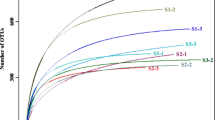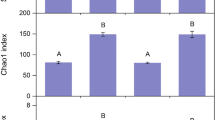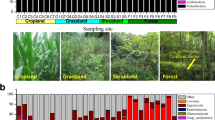Abstract
Agroforestry practices aim to achieve environmentally friendly land use. Fungi play a primarily role in soil organic carbon and nutrient maintenance, while the response of the soil fungi community to land use changes is little explored. Here, a high-throughput sequencing method was applied to understand the fungal community structure distinction in ginkgo agroforestry systems and adjacent croplands and nurseries. Our results showed that the agroforestry systems achieved better soil fertility and carbon contents. The agroforestry practices significantly altered the composition of soil fungal communities comparing with pure gingko plantation, adjacent cropland, and nursery. The dominant fungal phyla were always Ascomycota and Basidiomycota. The relative abundance of Ascomycota was correlated with the TN and AP, while the abundance of Basidiomycota was negatively correlated with the TN and NN. The soil organic carbon, total nitrogen, and nitrate nitrogen explained 59.80% and 63.36% of the total variance in the fungal community composition in the topsoil and subsoil, and the available phosphorus also played a key role in the topsoil. Considering soil fertility maintenance and fungal community survival and stability, the agroforestry systems achieved better results, and the ginkgo and wheat system was the best among the five planting systems we studied. In the ginkgo and wheat system, applying readily available mineral nitrogen fertilizer either alone or in combination with organic amendments will improve the soil quality and fertility.




Similar content being viewed by others
References
Anderson EK, Zerriffi H (2012) Seeing the trees for the carbon: agroforestry for development and carbon mitigation. Clim Chang 115:741–757. https://doi.org/10.1007/s10584-012-0456-y
Baldrian P, Kolarik M, Stursova M, Kopecky J, Valaskova V, Vetrovsky T, Zifcakova L, Snajdr J, Ridl J, Vlcek C, Voriskova J (2012) Active and total microbial communities in forest soil are largely different and highly stratified during decomposition. Isme J 6:248–258. https://doi.org/10.1038/ismej.2011.95
Bardgett RD, van der Putten WH (2014) Belowground biodiversity and ecosystem functioning. Nature 515:505–511. https://doi.org/10.1038/nature13855
Buee M, Reich M, Murat C, Morin E, Nilsson RH, Uroz S, Martin F (2009) 454 Pyrosequencing analyses of forest soils reveal an unexpectedly high fungal diversity. New Phytol 184:449–456. https://doi.org/10.1111/j.1469-8137.2009.03003.x
Caldwell BA (2005) Enzyme activities as a component of soil biodiversity: a review. Pedobiologia 49:637–644. https://doi.org/10.1016/j.pedobi.2005.06.003
Chen Y-L, Xu TL, Veresoglou SD, Hu HW, Hao ZP, Hu YJ, Liu L, Deng Y, Rillig MC, Chen BD (2017) Plant diversity represents the prevalent determinant of soil fungal community structure across temperate grasslands in northern China. Soil Biol Biochem 110:12–21. https://doi.org/10.1016/j.soilbio.2017.02.015
Clemmensen KE, Bahr A, Ovaskainen O, Dahlberg A, Ekblad A, Wallander H, Stenlid J, Finlay RD, Wardle DA, Lindahl BD (2013) Roots and associated fungi drive long-term carbon sequestration in boreal forest. Science 339:1615–1618. https://doi.org/10.1126/science.1231923
Daniel R (2005) The metagenomics of soil. Nat Rev Microbiol 3:470–478. https://doi.org/10.1038/nrmicro1160
Delgado-Baquerizo M, Maestre FT, Reich PB, Jeffries TC, Gaitan JJ, Encinar D, Berdugo M, Campbell CD, Singh BK (2016) Microbial diversity drives multifunctionality in terrestrial ecosystems. Nat Commun 7:10541. https://doi.org/10.1038/ncomms10541
Dhilhon SS, Anderson RC (1993) Growth dynamics and associated mycorrhizal fungi of little bluestem grass [Schizachyrium scoparium (Michx.) Nash] on burned and unburned sand prairies. New Phytol 123:77–91. https://doi.org/10.1111/j.1469-8137.1993.tb04533.x
Du C, Geng Z, Wang Q, Zhang T, He W, Hou L, Wang Y (2017) Variations in bacterial and fungal communities through soil depth profiles in a Betula albosinensis forest. J Microbiol 55:684–693. https://doi.org/10.1007/s12275-017-6466-8
Ehrmann J, Ritz K (2014) Plant: soil interactions in temperate multi-cropping production systems. Plant Soil 376:1–29. https://doi.org/10.1007/s11104-013-1921-8
El-Baruni B, Olsen SR (1979) Effect of manure on solubility of phosphorus in calcareous soils. Soil Sci 128:219–225. https://doi.org/10.1097/00010694-197910000-00005
Fan D, Zhang Y, Qin S, Wu B (2017) Relationships between Artemisia ordosica communities and environmental factors following sand-dune stabilization in the Mu Us desert, northwest China. J For Res 28:115–124. https://doi.org/10.1007/s11676-016-0289-z
Fierer N (2017) Embracing the unknown: disentangling the complexities of the soil microbiome. Nat Rev Microbiol 15:579–590. https://doi.org/10.1038/nrmicro.2017.87
Gu Y, Wang Y, Lu S, Xiang Q, Yu X, Zhao K, Zou L, Chen Q, Tu S, Zhang X (2017) Long-term fertilization structures bacterial and archaeal communities along soil depth gradient in a paddy soil. Front Microbiol 8:1516. https://doi.org/10.3389/fmicb.2017.01516
Guo J, Wu Y, Wang B, Lu Y, Cao F, Wang G (2016) The effects of fertilization on the growth and physiological characteristics of Ginkgo biloba L. Forests 7:293. https://doi.org/10.3390/f7120293
Guo J, Wang G, Geng Q, Wu Y, Cao F (2018) Decomposition of tree leaf litter and crop residues from ginkgo agroforestry systems in Eastern China: an in situ study. J Soils Sediments 18:1424–1431. https://doi.org/10.1007/s11368-017-1870-6
Hannula SE, Boschker HT, de Boer W, van Veen JA (2012) 13C pulse-labeling assessment of the community structure of active fungi in the rhizosphere of a genetically starch-modified potato (Solanum tuberosum) cultivar and its parental isoline. New Phytol 194:784–799. https://doi.org/10.1111/j.1469-8137.2012.04089.x
Högberg MN, Bååth E, Nordgren A, Arnebrant K, Högberg P (2003) Contrasting effects of nitrogen availability on plant carbon supply to mycorrhizal fungi and saprotrophs – a hypothesis based on field observations in boreal forest. New Phytol 160:225–238. https://doi.org/10.1046/j.1469-8137.2003.00867.x
Huhe CX, Hou F, Wu Y, Cheng Y (2017) Bacterial and fungal community structures in Loess Plateau grasslands with different grazing intensities. Front Microbiol 8:606. https://doi.org/10.3389/fmicb.2017.00606
Jeffries P, Gianinazzi S, Perotto S, Turnau K, Barea J-M (2003) The contribution of arbuscular mycorrhizal fungi in sustainable maintenance of plant health and soil fertility. Biol Fertil Soils 37:1–16. https://doi.org/10.1007/s00374-002-0546-5
Kerfahi D, Tripathi BM, Dong K, Go R, Adams JM (2016) Rainforest conversion to rubber plantation may not result in lower soil diversity of bacteria, fungi, and nematodes. Microb Ecol 72:359–371. https://doi.org/10.1007/s00248-016-0790-0
Kim YC, Gao C, Zheng Y, He XH, Yang W, Chen L, Wan SQ, Guo LD (2015) Arbuscular mycorrhizal fungal community response to warming and nitrogen addition in a semiarid steppe ecosystem. Mycorrhiza 25:267–276. https://doi.org/10.1007/s00572-014-0608-1
Koohafkan P, Altieri MA, Gimenez EH (2012) Green agriculture: foundations for biodiverse, resilient and productive agricultural systems. Int J Agric Sustain 10:61–75. https://doi.org/10.1080/14735903.2011.610206
Lehto T, Zwiazek JJ (2011) Ectomycorrhizas and water relations of trees: a review. Mycorrhiza 21:71–90. https://doi.org/10.1007/s00572-010-0348-9
Li S, Shakoor A, Wubet T, Zhang N, Liang Y, Ma K (2018) Fine-scale variations of fungal community in a heterogeneous grassland in Inner Mongolia: effects of the plant community and edaphic parameters. Soil Biol Biochem 122:104–110. https://doi.org/10.1016/j.soilbio.2018.04.007
Liang C, Jesus EDC, Duncan DS, Jackson RD, Tiedje JM, Balser TC (2012) Soil microbial communities under model biofuel cropping systems in southern Wisconsin, USA: impact of crop species and soil properties. Appl Soil Ecol 54:24–31. https://doi.org/10.1016/j.apsoil.2011.11.015
Lin X, Feng Y, Zhang H, Chen R, Wang J, Zhang J, Chu H (2012) Long-term balanced fertilization decreases arbuscular mycorrhizal fungal diversity in an arable soil in North China revealed by 454 pyrosequencing. Environ Sci Technol 46:5764–5771. https://doi.org/10.1021/es3001695
Liu Y, Shi G, Mao L, Cheng G, Jiang S, Ma X, An L, Du G, Johnson NC, Feng H (2012) Direct and indirect influences of 8yr of nitrogen and phosphorus fertilization on Glomeromycota in an alpine meadow ecosystem. New Phytol 194:523–535. https://doi.org/10.1111/j.1469-8137.2012.04050.x
Liu J, Sui Y, Yu Z, Shi Y, Chu H, Jin J, Liu X, Wang G (2015a) Soil carbon content drives the biogeographical distribution of fungal communities in the black soil zone of northeast China. Soil Biol Biochem 83:29–39. https://doi.org/10.1016/j.soilbio.2015.01.009
Liu X, Chen C, Wang W, Hughes JM, Lewis T, Hou E, Shen J (2015b) Vertical distribution of soil denitrifying communities in a wet sclerophyll forest under long-term repeated burning. Microb Ecol 70:993–1003. https://doi.org/10.1007/s00248-015-0639-y
Loreau M, Naeem S, Inchausti P, Bengtsson J, Grime JP, Hector A, Hooper DU, Huston MA, Raffaelli D, Schmid B, Tilman D, Wardle DA (2001) Biodiversity and ecosystem functioning: current knowledge and future challenges. Science 294:804–808. https://doi.org/10.1126/science.1064088
Lu RK (1999) Analytical methods of soil agrochemistry. China Agricultural Science and Technology Press, Beijing
Ma A, Zhuang X, Wu J, Cui M, Lv D, Liu C, Zhuang G (2013) Ascomycota members dominate fungal communities during straw residue decomposition in arable soil. PLoS One 8:e66146. https://doi.org/10.1371/journal.pone.0066146
Maestre FT, Delgado-Baquerizo M, Jeffries TC, Eldridge DJ, Ochoa V, Gozalo B, Quero JL, García-Gómez M, Gallardo A, Ulrich W, Bowker MA, Arredondo T, Barraza-Zepeda C, Bran D, Florentino A, Gaitán J, Gutiérrez JR, Huber-Sannwald E, Jankju M, Mau RL, Miriti M, Naseri K, Ospina A, Stavi I, Wang D, Woods NN, Yuan X, Zaady E, Singh BK (2015) Increasing aridity reduces soil microbial diversity and abundance in global drylands. Proc Natl Acad Sci USA 112:15684. https://doi.org/10.1073/pnas.1516684112
Magoc T, Salzberg SL (2011) FLASH: fast length adjustment of short reads to improve genome assemblies. Bioinformatics 27:2957–2963. https://doi.org/10.1093/bioinformatics/btr507
Major RT (1967) The ginkgo, the most ancient living tree. The resistance of Ginkgo biloba L. to pests accounts in part for the longevity of this species. Science 157:1270–1273. https://doi.org/10.1126/science.157.3794.1270
McNeely JA, Schroth G (2006) Agroforestry and biodiversity conservation – traditional practices, present dynamics, and lessons for the future. Biodivers Conserv 15:549–554. https://doi.org/10.1007/s10531-005-2087-3
Meier CL, Bowman WD (2008) Links between plant litter chemistry, species diversity, and below-ground ecosystem function. Proc Natl Acad Sci USA 105:19780. https://doi.org/10.1073/pnas.0805600105
Müller K, Kramer S, Haslwimmer H, Marhan S, Scheunemann N, Butenschön O, Scheu S, Kandeler E (2016) Carbon transfer from maize roots and litter into bacteria and fungi depends on soil depth and time. Soil Biol Biochem 93:79–89. https://doi.org/10.1016/j.soilbio.2015.10.015
Mushinski RM, Gentry TJ, Dorosky RJ, Boutton TW (2017) Forest harvest intensity and soil depth alter inorganic nitrogen pool sizes and ammonia oxidizer community composition. Soil Biol Biochem 112:216–227. https://doi.org/10.1016/j.soilbio.2017.05.015
Nair PKR (2007) The coming of age of agroforestry. J Sci Food Agric 87:1613–1619. https://doi.org/10.1002/jsfa.2897
Nair PR (2008) Agroecosystem management in the 21st century: it is time for a paradigm shift. J Trop Agric 46:1–12
Ohm RA, Feau N, Henrissat B, Schoch CL, Horwitz BA, Barry KW, Condon BJ, Copeland AC, Dhillon B, Glaser F, Hesse CN, Kosti I, LaButti K, Lindquist EA, Lucas S, Salamov AA, Bradshaw RE, Ciuffetti L, Hamelin RC, Kema GHJ, Lawrence C, Scott JA, Spatafora JW, Turgeon BG, de Wit PJGM, Zhong S, Goodwin SB, Grigoriev IV (2012) Diverse lifestyles and strategies of plant pathogenesis encoded in the genomes of eighteen Dothideomycetes fungi. PLoS Pathog 8:e1003037. https://doi.org/10.1371/journal.ppat.1003037
Peay KG, Garbelotto M, Bruns TD (2010) Evidence of dispersal limitation in soil microorganisms: isolation reduces species richness on mycorrhizal tree islands. Ecology 91:3631–3640. https://doi.org/10.1890/09-2237.1
Poeplau C, Don A (2013) Sensitivity of soil organic carbon stocks and fractions to different land-use changes across Europe. Geoderma 192:189–201. https://doi.org/10.1016/j.geoderma.2012.08.003
Porras-Alfaro A, Herrera J, Natvig DO, Lipinski K, Sinsabaugh RL (2011) Diversity and distribution of soil fungal communities in a semiarid grassland. Mycologia 103:10–21. https://doi.org/10.3852/09-297
Prober SM, Leff JW, Bates ST, Borer ET, Firn J, Harpole WS, Lind EM, Seabloom EW, Adler PB, Bakker JD, Cleland EE, DeCrappeo NM, DeLorenze E, Hagenah N, Hautier Y, Hofmockel KS, Kirkman KP, Knops JMH, la Pierre KJ, MacDougall AS, McCulley RL, Mitchell CE, Risch AC, Schuetz M, Stevens CJ, Williams RJ, Fierer N (2015) Plant diversity predicts beta but not alpha diversity of soil microbes across grasslands worldwide. Ecol Lett 18:85–95. https://doi.org/10.1111/ele.12381
Qin H, Wang H, Strong PJ, Li Y, Xu Q, Wu Q (2014) Rapid soil fungal community response to intensive management in a bamboo forest developed from rice paddies. Soil Biol Biochem 68:177–184. https://doi.org/10.1016/j.soilbio.2013.09.031
R Core Team (2017) R: a language and environment for statistical computing. R Foundation for Statistical Computing, Vienna, Austria
Read DJ, Perez-Moreno J (2003) Mycorrhizas and nutrient cycling in ecosystems – a journey towards relevance? New Phytol 157:475–492. https://doi.org/10.1046/j.1469-8137.2003.00704.x
Rinnan R, Bååth E (2009) Differential utilization of carbon substrates by bacteria and fungi in tundra soil. Appl Environ Microbiol 75:3611–3620. https://doi.org/10.1128/AEM.02865-08
Rodriguez RJ, White JF, Arnold AE, Redman RS (2009) Fungal endophytes: diversity and functional roles. New Phytol 182:314–330. https://doi.org/10.1111/j.1469-8137.2009.02773.x
Rousk J, Baath E, Brookes PC, Lauber CL, Lozupone C, Caporaso JG, Knight R, Fierer N (2010) Soil bacterial and fungal communities across a pH gradient in an arable soil. Isme J 4:1340–1351. https://doi.org/10.1038/ismej.2010.58
Schappe T, Albornoz FE, Turner BL, Neat A, Condit R, Jones FA (2017) The role of soil chemistry and plant neighbourhoods in structuring fungal communities in three Panamanian rainforests. J Ecol 105:569–579. https://doi.org/10.1111/1365-2745.12752
Schlatter DC, Schillinger WF, Bary AI, Sharratt B, Paulitz TC (2017) Biosolids and conservation tillage: impacts on soil fungal communities in dryland wheat-fallow cropping systems. Soil Biol Biochem 115:556–567. https://doi.org/10.1016/j.soilbio.2017.09.021
Schmidt SK, Nemergut DR, Darcy JL, Lynch R (2014) Do bacterial and fungal communities assemble differently during primary succession? Mol Ecol 23:254–258. https://doi.org/10.1111/mec.12589
Schoenholtz SH, Miegroet HV, Burger JA (2000) A review of chemical and physical properties as indicators of forest soil quality: challenges and opportunities. For Ecol Manag 138:335–356. https://doi.org/10.1016/S0378-1127(00)00423-0
Shibata H, Urakawa R, Toda H, Inagaki Y, Tateno R, Koba K, Nakanishi A, Fukuzawa K, Yamasaki A (2011) Changes in nitrogen transformation in forest soil representing the climate gradient of the Japanese archipelago. J For Res 16:374–385. https://doi.org/10.1007/s10310-011-0288-z
Smith SE, Read D (2008) Mycorrhizal symbiosis. Academic Press, London
Tanner EVJ, Sheldrake MWA, Turner BL (2016) Changes in soil carbon and nutrients following 6 years of litter removal and addition in a tropical semi-evergreen rain forest. Biogeosciences 13:6183–6190. https://doi.org/10.5194/bg-13-6183-2016
Tedersoo L, Bahram M, Dickie IA (2014a) Does host plant richness explain diversity of ectomycorrhizal fungi? Re-evaluation of Gao et al. (2013) data sets reveals sampling effects. Mol Ecol 23:992–995. https://doi.org/10.1111/mec.12660
Tedersoo L, Bahram M, Polme S, Koljalg U, Yorou NS, Wijesundera R, Ruiz LV, Vasco-Palacios AM, Thu PQ, Suija A, Smith ME, Sharp C, Saluveer E, Saitta A, Rosas M, Riit T, Ratkowsky D, Pritsch K, Poldmaa K, Piepenbring M, Phosri C, Peterson M, Parts K, Partel K, Otsing E, Nouhra E, Njouonkou AL, Nilsson RH, Morgado LN, Mayor J, May TW, Majuakim L, Lodge DJ, Lee SS, Larsson KH, Kohout P, Hosaka K, Hiiesalu I, Henkel TW, Harend H, Guo LD, Greslebin A, Grelet G, Geml J, Gates G, Dunstan W, Dunk C, Drenkhan R, Dearnaley J, de Kesel A, Dang T, Chen X, Buegger F, Brearley FQ, Bonito G, Anslan S, Abell S, Abarenkov K (2014b) Fungal biogeography. Global diversity and geography of soil fungi. Science 346:1256688. https://doi.org/10.1126/science.1256688
Torralba M, Fagerholm N, Burgess PJ, Moreno G, Plieninger T (2016) Do European agroforestry systems enhance biodiversity and ecosystem services? A meta-analysis. Agric Ecosyst Environ 230:150–161. https://doi.org/10.1016/j.agee.2016.06.002
Treseder KK, Lennon JT (2015) Fungal traits that drive ecosystem dynamics on land. Microbiol Mol Biol Rev 79:243–262. https://doi.org/10.1128/mmbr.00001-15
Udawatta RP, Kremer RJ, Garrett HE, Anderson SH (2009) Soil enzyme activities and physical properties in a watershed managed under agroforestry and row-crop systems. Agric Ecosyst Environ 131:98–104. https://doi.org/10.1016/j.agee.2008.06.001
van der Heijden MGA, Klironomos JN, Ursic M, Moutoglis P, Streitwolf-Engel R, Boller T, Wiemken A, Sanders IR (1998) Mycorrhizal fungal diversity determines plant biodiversity, ecosystem variability and productivity. Nature 396:69–72. https://doi.org/10.1038/23932
Voříšková J, Brabcová V, Cajthaml T, Baldrian P (2014) Seasonal dynamics of fungal communities in a temperate oak forest soil. New Phytol 201:269–278. https://doi.org/10.1111/nph.12481
Wang J, Ren C, Cheng H, Zou Y, Bughio MA, Li Q (2017a) Conversion of rainforest into agroforestry and monoculture plantation in China: consequences for soil phosphorus forms and microbial community. Sci Total Environ 595:769–778. https://doi.org/10.1016/j.scitotenv.2017.04.012
Wang Z, Li T, Wen X, Liu Y, Han J, Liao Y, DeBruyn JM (2017b) Fungal communities in rhizosphere soil under conservation tillage shift in response to plant growth. Front Microbiol 8:1301. https://doi.org/10.3389/fmicb.2017.01301
Yoshitake S, Fujiyoshi M, Watanabe K, Masuzawa T, Nakatsubo T, Koizumi H (2013) Successional changes in the soil microbial community along a vegetation development sequence in a subalpine volcanic desert on Mount Fuji, Japan. Plant Soil 364:261–272. https://doi.org/10.1007/s11104-012-1348-7
Yu Y, Stomph T-J, Makowski D, van der Werf W (2015) Temporal niche differentiation increases the land equivalent ratio of annual intercrops: a meta-analysis. Field Crop Res 184:133–144. https://doi.org/10.1016/j.fcr.2015.09.010
Zhang C, Liu G, Xue S, Wang G (2016) Soil bacterial community dynamics reflect changes in plant community and soil properties during the secondary succession of abandoned farmland in the Loess Plateau. Soil Biol Biochem 97:40–49. https://doi.org/10.1016/j.soilbio.2016.02.013
Zhou X, Zhang J, Gao D, Gao H, Guo M, Li L, Zhao M, Wu F (2017) Conversion from long-term cultivated wheat field to Jerusalem artichoke plantation changed soil fungal communities. Sci Rep `7:41502. https://doi.org/10.1038/srep41502
Funding
This work was supported by the Agricultural Science and Technology Independent Innovation Funds of Jiangsu Province (CX(16)1005), the National Key Research and Development Program of China (2017YFD0600700), the Priority Academy Program Development of Jiangsu Higher Education Institution (PAPD), the Postgraduate Research and Practice Innovation Program of Jiangsu Province (KYCX18_0955), and the Doctorate Fellowship Foundation of Nanjing Forestry University.
Author information
Authors and Affiliations
Corresponding author
Ethics declarations
Conflict of interest
The authors declare that they have no conflict of interest.
Additional information
Responsible editor: Zhihong Xu
Publisher’s note
Springer Nature remains neutral with regard to jurisdictional claims in published maps and institutional affiliations.
Electronic supplementary material
ESM 1
(DOCX 1029 kb)
Rights and permissions
About this article
Cite this article
Guo, J., Wang, G., Wu, Y. et al. Ginkgo agroforestry practices alter the fungal community structures at different soil depths in Eastern China. Environ Sci Pollut Res 26, 21253–21263 (2019). https://doi.org/10.1007/s11356-019-05293-w
Received:
Accepted:
Published:
Issue Date:
DOI: https://doi.org/10.1007/s11356-019-05293-w




